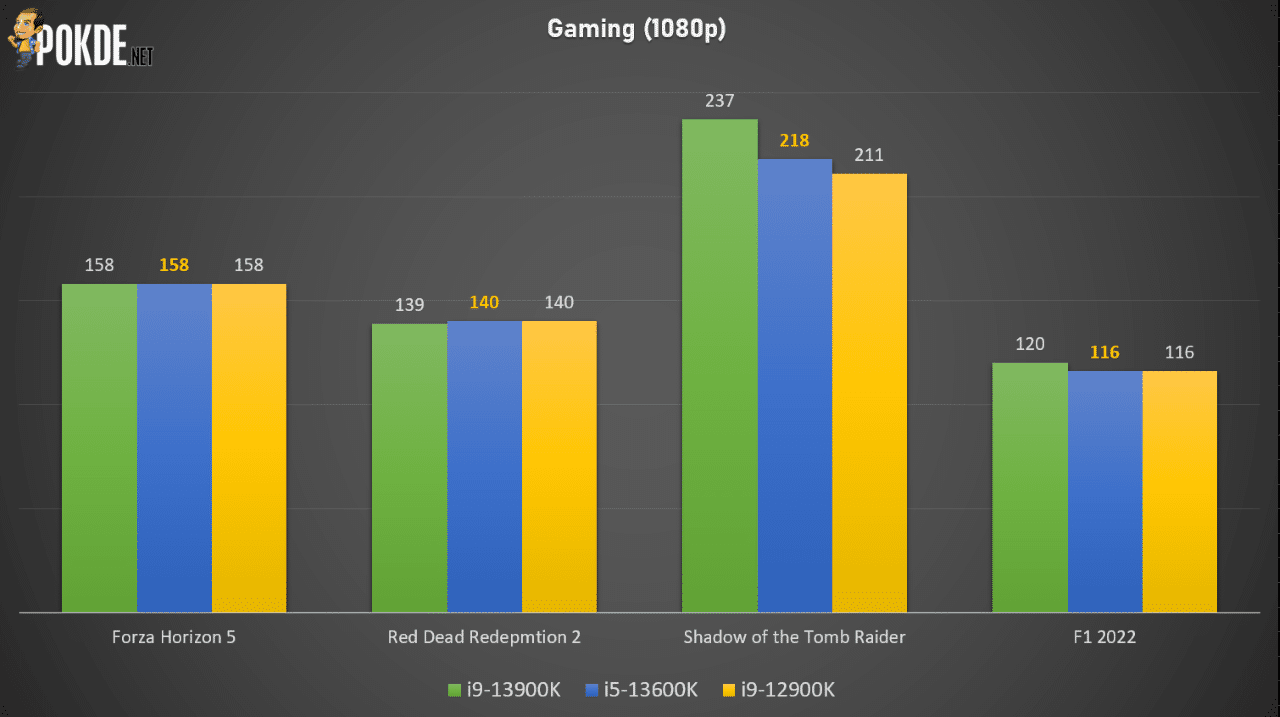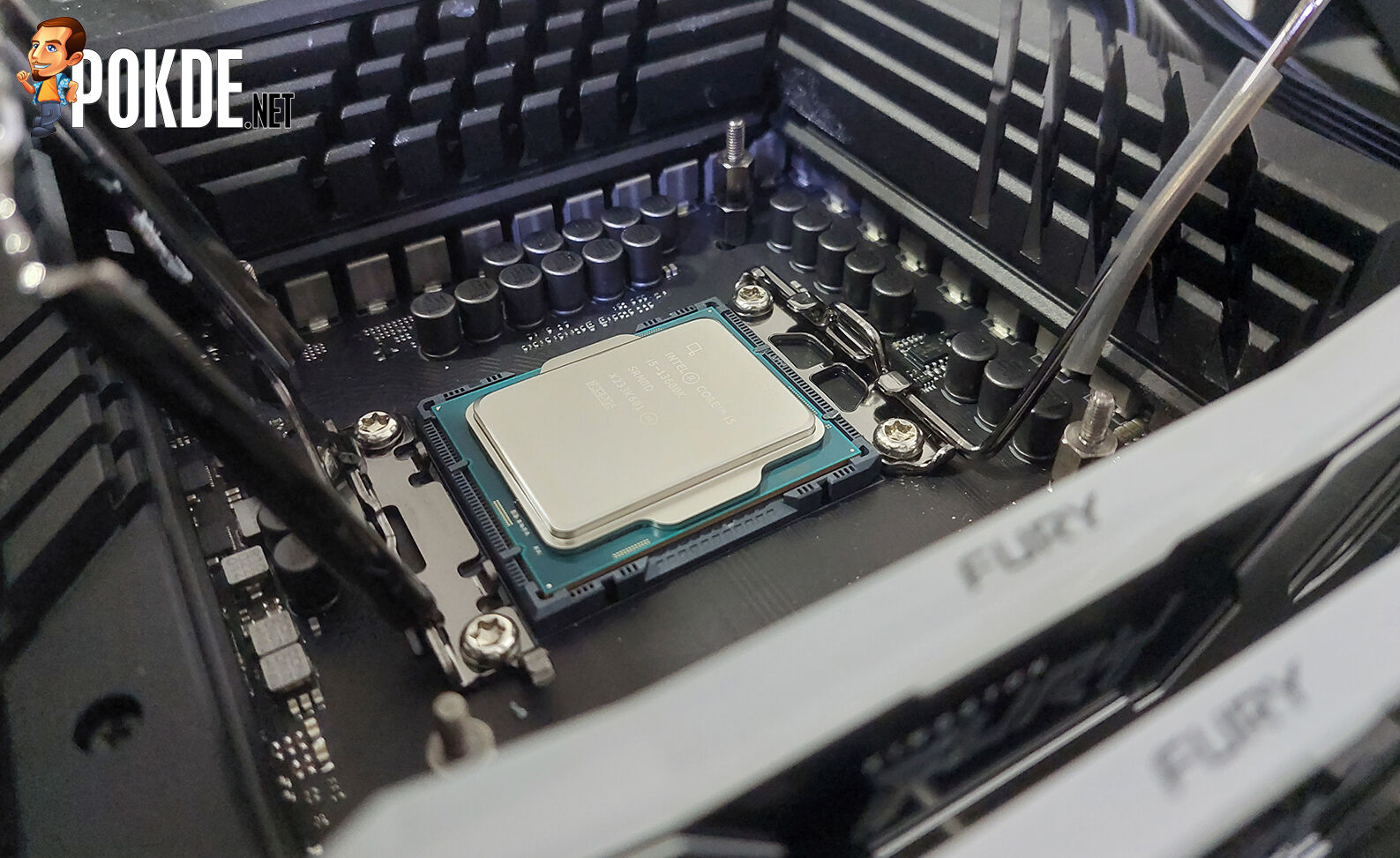Intel Core i5-13600K Review – A Punch Above Its Weight
-
Efficiency - 8/10
8/10
-
Features - 8.5/10
8.5/10
-
Performance - 8.5/10
8.5/10
-
Value - 9/10
9/10
Summary
The Intel Core i5-13600K is essentially Core i9-12900K on the cheap, offering similar performance at significantly less price.
Overall
8.5/10Pros
– Amazing performance for its class
– Improved IMC for higher DDR5 speeds
– Retains support for 600 series motherboards
– Price-competitive
Cons
– MTP not behaving as expected
Here comes the little brother among the Raptor Lake CPUs, the Intel Core i5-13600K. Just like its bigger Core i9 brother, it also gained extra E-Cores, a slight clockspeed bump, extra L2 cache and higher TDP limit. Let’s see what this CPU is made of, in detail.
Intel Core i5-13600K: Basic Specifications
| Processor | Intel Core i5-13600K |
| Core Configuration | 6P+8E / 14 cores, 20 threads |
| Process Node | Intel 7 (formerly 10ESF) |
| Microarchitecture | Raptor Cove (P-Core) / Gracemont (E-Core) |
| P-Core Max Turbo Clock | 5.1GHz |
| E-Core Max Turbo Clock | 3.9GHz |
| Cache (L2+L3) | 20+24MB |
| TDP (PBP / MTP) | 125W / 181W |
| Memory Support | DDR5-5600 / DDR4-3200, Max. 128GB dual-channel |
| Onboard Graphics | Intel UHD Graphics 770 @ 1.50GHz |
| PCIe Lanes Configuration | 16 (Gen 5) + 4 (Gen 4) |
| Socket | LGA1700 |
| Chipset Support | Intel 600 / 700 Series Chipset |
As mentioned above, the improvements over its direct predecessor, the Core i5-12600K, are similar to that of the flagship: 8x E-Cores instead of 4, +200MHz bump on P-Core, doubled L2 cache, and 181W MTP instead of 150W of the older model.
Test System
| Processor | Intel Core i5-13600K |
| Cooler & Thermal Paste | ASUS Ryujin II 360 AIO Cooler Master MasterGel Maker |
| Motherboard | ASUS ROG Maximus Z790 HERO (BIOS ver. 0502) |
| Graphics Card | NVIDIA RTX 3080 Ti Founders Edition Driver Version 522.25 |
| RAM | Kingston FURY RENEGADE DDR5-6400 (16GB x2) |
| Storage | Samsung SSD 980 PRO 256GB (Boot) Kingston NV1 1TB |
| Power Supply | Cooler Master V850 Platinum 850W |
| Case | VECTOR Bench Case (Open-air chassis) |
| Operating System | Windows 11 Pro 21H2 (Build 22000.1098) |
Before We Begin…
Few pre-requisites: first, Intel recommends Windows 11 if you intend to upgrade to 13th Gen CPUs (same applies to 12th Gen) – the Thread Director feature is optimized on the OS-level for Windows 11 based systems. If you do use Windows 10, expect performance deviations from the numbers presented below.
All tests follow Intel’s stock limits by turning off ASUS MCE (Multi-Core Enhancement) – a feature turned on by default for this motherboard which removes all power limits on the CPU installed. With that out of the way, let’s begin.
Benchmarks
Cinebench R23

Here we include previous flagship CPU, the Core i9-12900K for comparison. Single-core are slightly ahead of the Core i9-12900K; however, the multicore scores are surprisingly very close – and it looks like the improved P-Core has mostly covered the deficit of two less P-Cores over the 12900K.
One thing to note, the Core i5 has done so in much lesser power, at 156 watts as observed – which, weirdly enough – isn’t the MTP limit of this particular CPU. We couldn’t figure out why the CPU refuse to go past that limit despite XTU clearly says the limit is 181W per Intel’s specs (there’s no throttling involved whatsoever). That said, all subsequent multicore tests we observed has seen the CPU just hovering around 120-140W depending on workloads, so the numbers should still apply.
7-Zip

The theme from previous benchmark continues – the Core i5-13600K with its 6P+8E cores placed itself extremely close to the outgoing Core i9’s performance (8P+8E), with the 12900K leading at just 3% on compression metrics.
3DMark Time Spy

Here the Core i5-13600K is somewhat behind the Core i9-12900K, at 9% deficit – which is slightly surprising given how close these two are on the numbers above so far. How would that affect gaming performance in general? Read on.
Handbrake

This test is performed by transcoding a 10-minute source file (4K30) into H.264 MKV 1080p30 format. Here we see the Core i5-13600K is on the same ballpark in terms of duration, at just 7 seconds (or 3%) behind. Not bad for a midrange CPU at all…
Gaming

At this point I might sound like a broken record – but the numbers once again has shown the Core i5-13600K is pumping out the same amount of frames in the games we tested on (SOTTR has in fact elected the Core i5 as winner). On the grand scheme of things though, such performance is not far off of its big brother, the Core i9-13900K, and especially so if you go for higher resolutions. However, some games such as Forza Horizon 5 is especially bottlenecked by GPU, so you might be better off picking the Core i5 as there’s no point in getting the Core i9 if your PC’s sole purpose is to just game on GPU-bound titles like this one.
Conclusion
To describe this CPU in boxing terms – it packs quite the punch. Its direct competition from AMD will be Ryzen 5 7600X – also a six-core CPU. However, the extra E-Cores for the Core i5-13600K has given it a definite advantage on workstation tasks. But the more surprising part comes from the fact that it kept pace with the company’s previous best – the Core i9-12900K, which is nothing short of impressive especially with the expected pricing of CPUs within this segment.

However, I do want to point out the odd behavior of this CPU not utilizing fully its 181W of available power, which somehow has itself capped at 156W on all-core workloads like Cinebench. Single-core performance is in line of our expectations – slightly lower than contemporary Core i9-13900K but much improved over the 12900K. As far as gaming is concerned, you don’t really lose much, if at all, in overall performance; the GPU is more important anyway in that aspect, especially as you go for higher resolutions.
For those already on 12th Gen platforms, the Core i5-13600K can be seen as effectively a “much cheaper” Core i9-12900K, which makes it a very enticing upgrade, if the RCP of $318 (RM1,500 at current exchange rates) is any indication. For those yet to get onboard of DDR5 platforms though, the current pricing might still hold them off for a while. That said, if you’re after the multicore performance when picking your next midrange CPU, there’s no question – the Core i5-13600K has it in the bag.

Special thanks to Intel for providing the Intel Core i5-13600K for the purpose of this review. We would also like to thank ASUS Malaysia for providing us the ROG Maximus Z790 Hero and ROG Ryujin II 360, as well as Kingston for the their FURY RENEGADE DDR5 RGB memory kit.

























